|
1. The Gate Posts of the
Villa...
Like every Italian villa, there are gate posts at the entrance, these with
a gate made from the wheel of the sun become here the source for the
streaming waters of life pouring all down across the barrier of dead blood
that marks our world of daily life that is below the bottom of the
collage.
|
2. The fishpond of the villa...
with an old
terracotta urn beside it, derived from the pond and urn at Green
Gates.
|
3. The doorway to the garden...
with the top of the wall derived from the
wall of the back patio at Green Gates.
|
4. The wall of the garden...
and the vision beyond into Paradise land with
the deep red sun of eternity, the blue sky and the yellow of the sun of joy. |
|
There are many folders of 1960-61 work that are
concerned with the phallic, many others where the aesthetic is the
primary concern and still others with "the lost" as focus.
The "Cock Book" folder above can stand for the
phallic. The next seven images--gathered from many different
folders--may represent the aesthetic. |
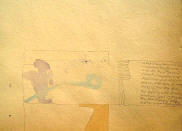
1.
“What I say here...
will have meaning only to me; and its leap toward beauty
(capture and dwelling) will be only mine and only for me, and only for
now. And, if the leap fail, the failing will be even enough, will be
anyway the marking of Today and the sign of my Time.” |
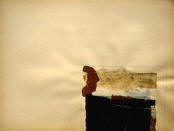
2. "Declaring on the side of...
the aesthete: for his perfect tastes in
everything--for his exacting... after all, frequent come."
|

3. "One touch of beauty...
and of blood, a ring at the start of the
stream, and all of this for sorrow for the lost books."
|
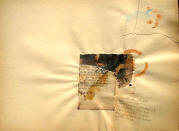
4. "Day after day...
the old slow closing up of the world (ivory,
incandescent) there on the other side of the horizon--dim now and dark
and dull with rose." |
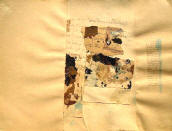
5.
“At the Bosco Parrasio (Azulehos)”
“For old
pages of the… century, like then what I want is for it to be like finding
an old page in a junk store a century from now in which are the signs of a
passage immeasurably far, the marks of an apotheosis forgot a hundred
years before and stained there in its passage into the far marked dim upon
the page”
“…to look at the sun upon grassy parterres, and sleep in the shadows
of pines and read in old authors”
|
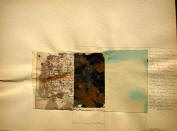
6.
“from December of 1959...
the imagery of the last few days—crepuscular: dim
skies strewn far with lamps golden and flaring. Thus may I see how
in that time (if it were now as it had been or may in some future be) I
might walk upon long streets and stop to paint the distances of the
eye—gray, rose, and golden with necklace of old and yellow gems and other
diamonds…
"Great Journeys in the Afternoon” |
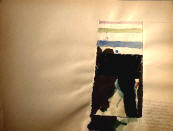
7. "A cock in the darkness...
of late spring rains, and skies earths: and
the distances of the senses and the ecstasies of the aesthete, for his
is the kingdom of heaven and the power and glory of life." |
|
And if you ever wanted to
know what my work was (is) about, it’s right there in this folder… The
phallic, the aesthetic, and the lost.
First, the phallic—that
first collage in the folder: with the sign of my cock marked across the
gold of heaven, on its way from earth to sky and God.
Second, the
aesthetic—“Day after day, the old slow closing up of the world (ivory,
incandescent) there on the other side of the horizon—dim now and dark and
dull with rose.” And the majolica—the urn I had just bought from an
art shop in Sausalito and that was broken in the Loma Prieta earthquake in
1989—was also the powerful sign, as an object fully expressive of Green
Gates, the powerful sign of the aesthetic.
Third, the loss—
Betty Mae was as I
remember (and Jean’s father’s side of her family was always obscure to the
Garibaldi side) Jean’s father’s nephew’s daughter. I heard of her as
a no person when once the nephew dropped in at 2998 Pacific Avenue.
Jean’s family made him welcome in the way that says “Don’t come back,” and
afterward there was a little bit of talk about Betty Mae (as Jean’s family
said, not very bright like the rest of Jean’s father’s side of the family)
and whatever happened to her … lost in the shuffle and failure of the
years.
And what is my work
about?—that I can’t stand (in the deepest, deepest sense) that kind of
loss. Thinking of Betty Mae then in 1960 (and it must have been
sometime in the very early 1950’s that Betty Mae’s father had visited
Jean’s family when I was there) and thinking now of why Betty Mae came up
in a 1960 collage, it is clear that my work comes from fear that I too
will be lost as she was. She is now nothing but a name known to no
one but me, all the others are dead and their memories gone. And she
was only a name and not a person to me, a name as a symbol of a horror I
could not bear.
The horror of loss I
cannot bear--
The loss of the
aesthetic, all the sensuous memories heaped in me..
The loss of the phallic:
all the life forever roiling in my crotch and rolling up my body, the eros
that has driven me since I was a child…
The loss of all that the
heart holds—and that is what Betty Mae meant (and also my mother, when I
made a collage that year about Leona and it conflated in my mind with the
Betty Mae collage)—the loss of all that the heart holds is the loss of
everything.
Yes, I cannot stand that
kind of loss. Yet, it is inevitable and absolute for all people and
all things. Vincent Van Gogh said, “What does it matter if a man [he
was speaking of painters] dies, because another rises in the same place?”
Yes, another does rise, but he is not me.
And so my art is about
loss. It is the cry of my soul to God: NO!
|
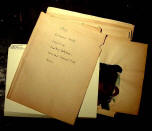
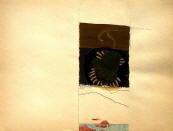
First, the phallic
"There must be a message written upon the gold bar
of Heaven"
And the mark of my cock was there.
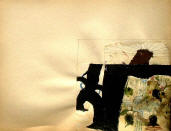
Second, the Aesthetic
Iranian composition with garden.
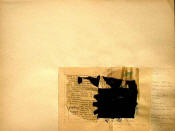
Third, the Loss.
"Goodbye, Betty May...
On down the drain to nothing
with you now."
|
My
early work at Green Gates, 1960-61.